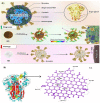Biosynthesis of Quantum Dots and Their Therapeutic Applications in the Diagnosis and Treatment of Cancer and SARS-CoV-2
- PMID: 37646053
- PMCID: PMC10460808
- DOI: 10.34172/apb.2023.065
Biosynthesis of Quantum Dots and Their Therapeutic Applications in the Diagnosis and Treatment of Cancer and SARS-CoV-2
Abstract
Quantum dots (QDs) are semiconductor materials that range from 2 nm to 10 nm. These nanomaterials (NMs) are smaller and have more unique properties compared to conventional nanoparticles (NPs). One of the unique properties of QDs is their special optoelectronic properties, making it possible to apply these NMs in bioimaging. Different size and shape QDs, which are used in various fields such as bioimaging, biosensing, cancer therapy, and drug delivery, have so far been produced by chemical methods. However, chemical synthesis provides expensive routes and causes serious environmental and health issues. Therefore, various biological systems such as bacteria, fungi, yeasts, algae, and plants are considered as potent eco-friendly green nanofactories for the biosynthesis of QDs, which are both economic and environmentally safe. The review aims to provide a descriptive overview of the various microbial agents for the synthesis of QDs and their biomedical applications for the diagnosis and treatment of cancer and SARS-CoV-2.
Keywords: Biological synthesis; Cancer therapy; Microorganisms; Quantum dots; SARS-CoV-2.
©2023 The Authors.
Conflict of interest statement
Authors declare no conflict of interests.
Figures
Similar articles
-
Bacterial Synthesis of Ternary CdSAg Quantum Dots through Cation Exchange: Tuning the Composition and Properties of Biological Nanoparticles for Bioimaging and Photovoltaic Applications.Microorganisms. 2020 Apr 27;8(5):631. doi: 10.3390/microorganisms8050631. Microorganisms. 2020. PMID: 32349316 Free PMC article.
-
Cyanobacteria: miniature factories for green synthesis of metallic nanomaterials: a review.Biometals. 2022 Aug;35(4):653-674. doi: 10.1007/s10534-022-00405-5. Epub 2022 Jun 18. Biometals. 2022. PMID: 35716270 Review.
-
Nanobioprospecting of photoautotrophs for the fabrication of quantum dots: mechanism and applications.Front Chem. 2024 Oct 15;12:1458804. doi: 10.3389/fchem.2024.1458804. eCollection 2024. Front Chem. 2024. PMID: 39473564 Free PMC article. Review.
-
Luminescent quantum dots: Synthesis, optical properties, bioimaging and toxicity.Adv Drug Deliv Rev. 2023 Jun;197:114830. doi: 10.1016/j.addr.2023.114830. Epub 2023 Apr 20. Adv Drug Deliv Rev. 2023. PMID: 37086917 Review.
-
Microbial synthesis of chalcogenide semiconductor nanoparticles: a review.Microb Biotechnol. 2016 Jan;9(1):11-21. doi: 10.1111/1751-7915.12297. Epub 2015 Jun 25. Microb Biotechnol. 2016. PMID: 26110980 Free PMC article. Review.
Cited by
-
Quantum Dots in Cancer Theranostics: A Thorough Review of Recent Advancements in Bioimaging, Tracking, and Therapy Across Various Cancer Types.Curr Pharm Biotechnol. 2025;26(8):1120-1142. doi: 10.2174/0113892010294163240407153842. Curr Pharm Biotechnol. 2025. PMID: 38644717 Review.
References
-
- Devi S, Kumar M, Tiwari A, Tiwari V, Kaushik D, Verma R, et al. Quantum dots: an emerging approach for cancer therapy. Front Mater. 2022;8:798440. doi: 10.3389/fmats.2021.798440. - DOI
-
- Soosani N, Ashengroph M, Chehri K. Extracellular green synthesis of zinc oxide nanoparticle by using the cell-free extract Rhodotorulapacifica NS02 and investigation of their antimicrobial activities. Nova BiologicaReperta. 2021;8(3):195–205. doi: 10.52547/nbr.8.3.195. - DOI
-
- Borovaya MN, Burlaka OM, Yemets AI, Blume YB. Biosynthesis of quantum dots and their potential applications in biology and biomedicine. In: Fesenko O, Yatsenko L, eds. Nanoplasmonics, Nano-Optics, Nanocomposites, and Surface Studies. Cham: Springer; 2015. p. 339-62. 10.1007/978-3-319-18543-9_24. - DOI
-
- Ashengroph M. Isolation and characterization of a native strain of Aspergillus niger ZRS14 with capability of high resistance to zinc and its supernatant application towards extracellular synthesis of zinc oxide nanoparticles. Biological Journal of Microorganism 2013;2(7):29-44. [Persian].
-
- Ashengroph M, Hosseini SR. Synthesis analysis and antibacterial activity of selenium nanoparticles produced by Pseudomonas alcaligenes. J Microbial World. 2019;12(3):252–66.
Publication types
LinkOut - more resources
Full Text Sources
Miscellaneous






